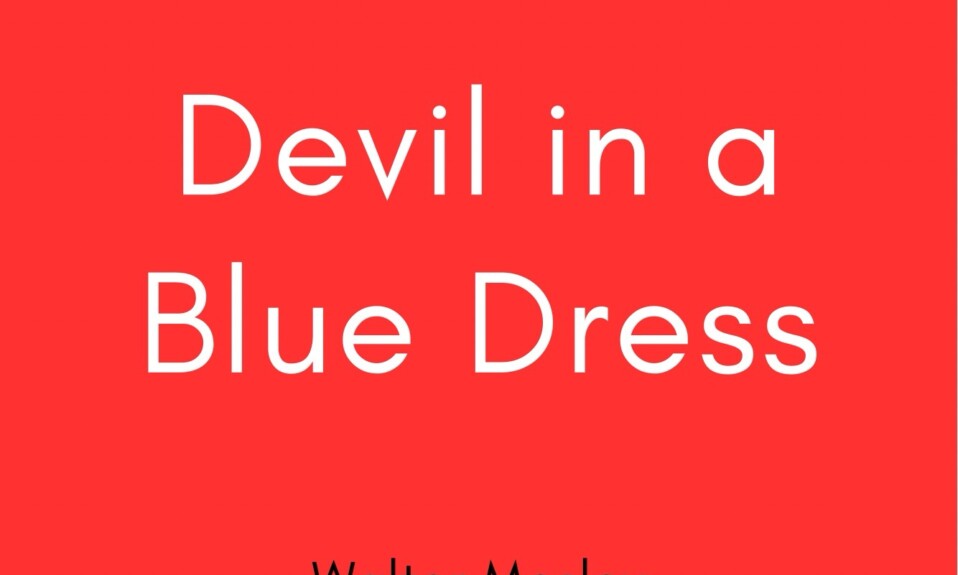
Overview
Walter Mosley wrote Devil in a Blue Dress, a hardboiled mystery novel, in 1990. Mosley’s first published novel, Devil in a Blue Dress, is also the first installment in his series featuring detective Ezekiel “Easy” Rawlins. Mosley investigates the complex interplay of race, class, and identity in mid-century Los Angeles, while also confronting the brutal standards of hardboiled detective fiction. Mosley’s Devil in a Blue Dress gained critical accolades, including a Shamus Award for Best First P.I. Novel. The novel was turned into a 1995 film starring Denzel Washington and a 1996 BBC Radio show. The citations in this guide relate to the 2020 Washington Square Press 30th anniversary paperback edition. Please be aware that this guide discusses abusive sexual circumstances, such as pedophilia and incest; it also obscures the usage of the n-word in referenced material.

Chapter 1
The novel’s opening scene in Joppy’s pub depicts Easy at a crossroads in his life while also introducing significant themes and characters. Easy’s first-person narration demonstrates a high level of self-awareness and retroactive knowledge, as he recounts the narrative from a future date with the advantage of hindsight. Easy, as a narrator, begins his first meeting with Albright with the observation, “I should have gotten up and walked out of there”, adding a sense of foreboding and fatalism, which are common characteristics of hardboiled and noir literature. Mosley also establishes character motivations, including competing ones. Albright is solely motivated by money, and he communicates with people in purely financial terms. Easy likewise places a great value on money, but he balances it with concerns about safety and morality, as he only promises to look for Daphne if she is safe. Easy’s early reservations laid the groundwork for his eventual conflicted sentiments about violence and his violent comrade, Mouse.
Mosley also highlights how racism influences Easy’s work as a detective in these chapters. Easy almost doesn’t get the job because of the white man’s bigotry and suspicion, who only reluctantly allows him into the building that houses Albright’s offices. Furthermore, Easy’s unease with the search for Daphne stems from his impression of her as an attractive white woman. At the time the story was set, racial segregation was the standard, and many states made interracial unions illegal. California’s anti-marriage legislation was overturned by the state’s top court in 1948, the same year that this novel takes place. However, the societal shame associated with such unions outlived the law. Easy’s attraction to Daphne is pitted against his wish to keep a low profile and avoid trouble.
Stylistically, these chapters use vivid, image-rich prose to set an emotive tone for the work. Easy writes about Joppy’s bar, “The dark cracks twisting through the light marble looked like a web of blood vessels in a newborn baby’s head”. Images like this one not only provide readers with appropriate imagery suggesting violence, precarity, and Easy’s dread, but also produce a variety of subtle moods and affects, ranging from sad to humorous.
Chapter 2
In these chapters, LA’s relevance as a setting becomes clearer. Easy, a native Texan, traveled to California to escape his past. Historically, his migration was considered part of the Great Migration, which saw millions of African Americans flee the South between 1916 and 1970 in quest of better socioeconomic conditions. Easy, for his part, seemed to be particularly interested in avoiding his relationship with Mouse and earning more money than he could in Texas. Though Easy chooses to stay in LA, he occasionally wonders if Sophie was correct about the place, implying that he is midway between Mouse’s thrill-seeking desire and Sophie’s admiration for a softer existence. More broadly, these chapters depict Los Angeles as a hive of corruption, with police brutality deemed normal and sexual predators such as Matthew Teran striving for positions of authority. The conversation between Easy and Odell even implies that LA is beyond God’s power.
These chapters also explore Easy’s and other characters’ attitudes about violence. While Easy appears to embrace the occasional necessity of violence, as evidenced by his willingness to fight in WWII, he wants to distance himself from Mouse and Albright’s uncontrolled, illegal violence, such as when Albright attacks the youths in the park. Easy’s claim that he would never harm children gets a giggle from Albright, who is unconcerned about morals. In an ironic twist, Albright and Mouse’s violent impulses are no worse than those of the official police, who treat Easy with extra malice because he is black. They labor in complimentary roles while challenging Easy, despite their seeming differences in appearance (Miller is tall and thin, Mason is heavy). Miller gently asks questions while softly restraining Mason, whose simmering wrath threatens physical violence on a regular basis. Racism pervades every aspect of their approach, from their interest in the case, which focuses on the deaths of white rather than Black individuals, to their illegal arrests without clearly identifying charges, and the physical and verbal assaults they inflict on Easy during questioning. They so capture the historical reality of police brutality against Black people in the United States.
Mosley continues to deepen the narrative with powerful imagery, as when Easy says, “Central Avenue was like a giant black alley, and I felt like a small rat, hugging the corners and looking out for cats”. Though he is innocent of any wrongdoing, Easy gives the appearance of being perpetually on the run, possibly because prejudice follows him everywhere. This emotional quality of danger and suspicion is common in the noir and hardboiled detective genres, but Mosley adds depth by combining narrative strategies with the psychological realism of Easy’s specific feelings as a Black man navigating Los Angeles’ criminal underworld in 1948.
ALSO READ: Summary of Restart by Gordon Korman – summary shelf
Chapter 3
Throughout these chapters, Easy fights to act autonomously in the face of opposing forces and influences. In addition to chasing the money provided by Albright and Carter, he develops feelings for Daphne. His first meeting with her has him drawn in almost against his will: “I should have taken Odell’s advice right then and left California for good” (90), he reflects as narrator. His somber narrative distinguishes Daphne as a femme fatale, a classic female figure who lures men into terrible circumstances, as she does here by luring him to the scene of Richard’s murder. The title Devil in a Blue Dress alludes to Shorty Long’s 1964 song “Devil with a Blue Dress,” which depicts a beautiful but dangerous woman. Daphne is portrayed as the eponymous “Devil,” a seductive yet ethically conflicted lady at the heart of the novel’s intrigue.
These external factors clash with Easy’s unwavering survival drive, which emerges as a voice in his head that initially appeared during his military experience. Easy’s background as a soldier in the midst of brutal conflict is juxtaposed with his present existence in Los Angeles, and the gap between the two is not as dramatic as one might imagine. He finds himself in perilous, life-or-death situations in Los Angeles, just as he did during the war, while investigating a murder case. Despite Easy’s efforts to control his emotions, he has a strong visceral reaction to violence and death, such as at Richard’s home. This contrasts with the stereotypically harsh or cynical detectives of the hardboiled genre, demonstrating Mosley’s bending of basic conventions to further examine Easy’s complexity. Furthermore, conflicts between black and white soldiers during the war parallel Easy’s strained relationship with Albright. Overall, Easy’s reliance on speech adds coherence to these events and demonstrates how such a terrible atmosphere can force ordinarily peaceful people like Easy to act in unexpected ways.
One of these surprises occurs in Chapter 17, when Easy begins to investigate the matter on his own, going over Albright’s head to see Carter. Within Lion Investments’ workplace, Easy only succeeds to approach Carter after successfully managing the anxieties and racist opinions of employees at various levels of the organizational hierarchy. The office’s actual space arrangements, such as the secret, locking elevator, allude to the numerous levels of bureaucracy and discrimination that Easy must navigate in order to reach Carter. The space metaphorically foreshadows Easy’s later discovery that Carter is so divorced from Easy’s life experience that he effectively dehumanizes Easy.
In terms of setting, these chapters make Easy’s home the major site of conflict. Albright’s intrusion contrasts with his pride and optimism at the prospect of owning his own home. Easy stands up to Albright more at home than he would elsewhere, as seen by his telling Albright to pour his own beverages. Only after Albright’s visit does Easy begin to feel afraid in his own house, resulting in nightmares, prompting him to bring in Mouse to supplement his efforts in light of his own fragility.
Chapter 4
These chapters begin with Easy’s visit to Ernest’s barbershop. Mosley portrays the barbershop and its residents in a frank, slice-of-life style. In some ways, the barbershop is a welcome respite from the insanity of the outside world: Easy likens it to a “social club [that] had to have order to run smoothly” , and he watches with delight as Ernest keeps Lenny from hitting Jackson. Ernest’s benign authority, particularly his benevolence to Zeppo, stands out even more against the sordid backdrop of Los Angeles, where murder is rampant and officials are corrupt.
Mosley broadens his assessment of war and its consequences in this section by focusing on the perspectives of Holocaust survivors rather than combatants. The contrast between Abe and Johnny demonstrates how trauma affects people in different ways, whilst Tree Rat’s death highlights the pointless brutality of violence against civilians.
This segment continues Easy’s evolution as a detective. Though he enjoys and is adept at his job, he makes certain blunders that are most likely due to his inexperience. Most notably, he is overt in his quest for Frank, prompting Jackson to report his interest to Frank, who later ambushes Easy at his house. Frank’s dark clothes establishes him as a contrast to Albright, connecting this scenario to Albright’s previous presence in Easy’s home. Frank’s presence as an even larger menace in Easy’s home demonstrates that Easy’s previously commonplace life has now become fully immersed in the case’s devastating chaos; the divide between the hazardous outside world and his private, domestic life no longer exists. This claim is reinforced by Mason and Miller’s later entry into Easy’s residence, where they “put [Easy] in a chair and stood over [him]”.
Easy grudgingly allows Mouse to become more involved in his case as he realizes things are spiraling out of control. Though having Mouse around makes it easier to acquire what he wants, Mouse’s aggressive tendencies endanger everyone around him, even Easy, as Mouse’s inebriated threats indicate. Mouse thus provides Easy with the option of working alone but ineffectively or moving the case forward more quickly with Mouse’s assistance but at the expense of more violence. Easy chooses the latter option, allowing himself to be morally tainted once more by his relationship with Mouse—another common dynamic in the noir genre.
ALSO READ: The Subtle Art of Not Giving a F*CK Summary by Mark Manson
Chapter 5
The climax chapters eventually resolve the questions of who killed whom and why. The killers’ identities, methods, and motivations vary, but Easy’s critical moment of anagnorisis, or realization, occurs when he discovers that Daphne is also Ruby, Frank’s half-sister. Easy describes the moment as a “earthquake.” His horror stems not from her affiliation with Frank, but from the idea that she is not white. This news shatters their already tense relationship, which was founded on her supposed identity as Daphne. Their previous friendship becomes even more significant in light of Mouse’s statements comparing Easy to Daphne. Easy’s relationship with a woman he considered to be white allowed him to consider living with the privileges of a white person; Daphne’s capacity to transfix Easy, a Black guy, validated her claimed identity.
Easy’s visit to Daphne at the motel reveals that he is denying his affections for her. Though he tells the skeptical manager that he merely wants to speak with Daphne, even stating that he would be pleased to converse with her over coffee, his actions indicate otherwise, as he leads her to a hidden room at Primo’s hotel for a tryst. Easy’s loss of perspective on the case as he falls for Daphne reinforces her status as a mysterious and attractive femme fatale. Easy’s desire to Daphne is more than just physical: “She’d whisper a sweet word and I was brought back to the first time I felt love and loss”, he says. The juxtapositions of love and loss, attraction and dread, and sex and death that surround Daphne point to the duality of her character, including her identity as Ruby Hanks. Her assertion that she and Easy can finally be themselves when they are alone together alludes to the constructed, performative character of identity, as well as the limitations of roles defined in society based on race, class, and gender.
These chapters also continue to explore topics of violence and justice. Easy’s relationship with Mouse hits a breaking point when Mouse goes on a rampage of violence, killing three individuals, much to Easy’s dismay. However, if Mouse had not shown, Easy would have died, highlighting the conundrum of Easy’s existence as a would-be law-abiding Black man: if he does not break the laws on occasion or find allies to do so, he will be crushed by others who are more prepared to act immorally. Thus, despite Easy’s shame and dismay at Mouse’s actions, he also defends him, resisting Daphne’s plea to kill him and protecting him from the law. Meanwhile, he turns in Junior, who serves no use for Easy. Though Odell assures Easy that it was just luck, Easy’s laughing in the novel’s final scene is almost definitely empty, reflecting his tentative acceptance of the impossibility of pure morality.



